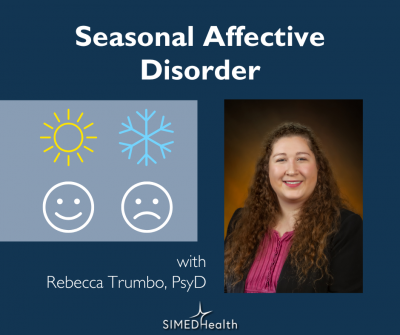
Seasonal Affective Disorder
With Dr. Rebecca Trumbo, a SIMEDHealth Psychologist.
To learn more about Rebecca Trumbo, PsyD, click here.
To make an appointment with SIMEDHealth Psychology, click here.
Seasonal Affective Disorder also known as SAD is a type of depression with a seasonal pattern. SAD is similar to major depression, but the symptoms of depression typically only occur in the fall or winter seasons. These symptoms seem to occur during months when there is less sunlight and the symptoms tend to improve in the spring when there is more sunlight.
As the seasons change and there are less daylight hours there is a change in our circadian rhythms, our internal biological clocks. This shift can make individuals feel off and impacts the brain. Thus, leading to changes in processes and behaviors regulated by the circadian rhythm like sleep, mood, metabolism, and energy.
One of the major differences between a seasonal pattern of depression and recurrent major depressive disorder is the onset of the depressive episode is influenced by seasons that have less sunlight, and the ensuing remission is influenced by the change in season as well. Additionally, two years of this noticeable pattern of onset in the fall or winter and remission in the spring needs to be evident. Furthermore, other episodes of depression cannot outnumber the seasonal depressive episodes.
SAD should be diagnosed by a mental health or other healthcare provider. The DSM-5-TR is a manual written by the American Psychiatric Association, by which mental health conditions are diagnosed. In order to be diagnosed with SAD, all necessary criteria need to be met based on the DSM-5-TR. These criteria include: there needs to be a regular temporal relationship between the onset (fall/winter) of an episode and the remission of the episode (spring), two years of this pattern have occurred, and the seasonal pattern outnumber the non-seasonal patterns. Major Depressive Disorder symptoms include: feeling sad or depressed, loss of interest in activities or loss of pleasure, insomnia or sleeping too much, significant weight loss or gain, agitation or slowing down, fatigue or loss of energy, feelings of worthlessness or excessive guilt, difficulty with concentration or indecisiveness, and suicidal ideation or thoughts about dying.
If you have SAD there are some lifestyle changes that you can make to try and improve your symptoms. Light therapy can be helpful for those who suffer from SAD. Also, a healthier diet, regular exercise, managing stress, sleeping an adequate amount and managing other health issues can be mediators for depressive symptoms. It is also advisable to follow up with your Primary Care physician or nurse practitioner to ensure your vitamin D levels are adequate.
Psychotropic medications (antidepressants) can be helpful for depressive episodes. Additionally, seeking professional help through psychotherapy can be helpful for those who are suffering with depressive symptoms and episodes. There are many evidence based treatment modalities that can help with depression like cognitive behavioral therapy (CBT) and acceptance and commitment therapy (ACT).